China’s Belt and Road Initiative a plus, the rest so-so on Hong Kong-Chiang Mai journey
- A Hong Kong resident's trip to Chiang Mai via Laos on Chinese-built railways, then by road, mostly smooth with a few bumps along the way
A trip from Hong Kong to Chiang Mai using Chinese-built railways and a road shows what a boon China's Belt and Road Initiative has been, and what's missing in less developed Southeast Asia.
Day 1: Hong Kong - Kunming (February 5, 2024)
It is Monday morning, five days before the start of the Lunar New Year holiday, and my wife and I have just left our home in Hong Kong, destined for Chiang Mai, in northern Thailand.
We take the MTR together, but while Mimi heads straight for Hong Kong International Airport, I have decided to take a more roundabout way, following the Belt and Road Initiative between the two locations.
Do you have questions about the biggest topics and trends from around the world? Get the answers with SCMP Knowledge, our new platform of curated content with explainers, FAQs, analyses and infographics brought to you by our award-winning team.

A high-speed train pulled in at Kunming Nan (Kunming South) Railway Station. Photo: Kristian Odebjer
So with my wife just a few hours away from being able to order a bowl of authentic khao soi, I board a high-speed train at West Kowloon Station.
We have all heard a lot over the past 10 years about newly built railways, ports and highways in far-flung places all enabled by the Belt and Road Initiative.
While China's domestic high-speed railway is not included in the initiative, it still falls under the "make massive infrastructure investments and there will be growth" philosophy favoured by Beijing, and thus qualifies as an acceptable mode of transport for my expedition.
My train on the gaotie (high-speed railway) takes passengers 1,500km (930-mile) across southern China to Kunming, Yunnan province, in a mere seven-and-a-half hours. My mind boggles at the engineering effort that must have been involved in negotiating the mountainous terrain.
At times it feels like riding the MTR, with the train running through seemingly never-ending tunnels.
The high-speed rail network has opened up China to travellers in a way that was unimaginable when I first visited as a student in the 1990s, when overnight "sleeping buses" and overcrowded "slow" trains were the standard modes of long-distance transport.
I do not feel nostalgic for those days of rough travel as I watch the scenery whizz by from my comfortable seat.
The views (between the tunnels) are a mix of modern cities and rural villages, limestone hills and meandering rivers - however, at speeds of up to 300km/h, everything tends to blur into an impressionist painting.
There are plenty of new-looking cars parked next to farmhouses, while the oversupply of apartment buildings in more urban settings is visible: it seems like every city has its share of abandoned or paused residential projects. Many highways appear vastly underused or not even open for traffic.
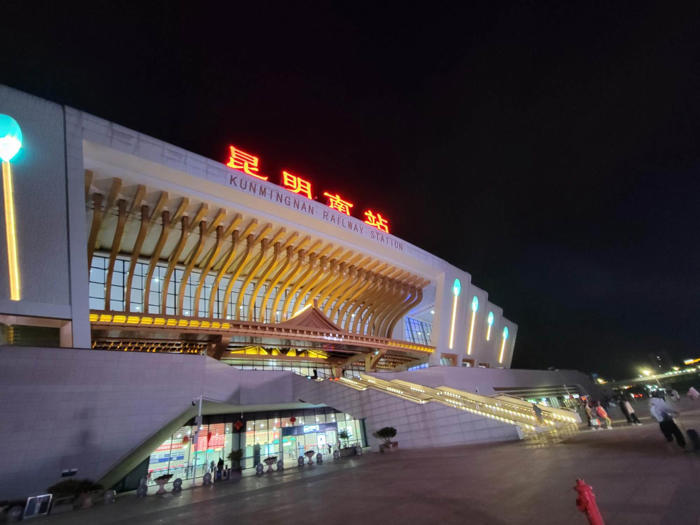
Kunming Nan (Kunming South) Railway Station at night. Photo: Kristian Odebjer
The mood on the train is upbeat. Passengers are heading back to see their extended families for the holiday, and many are bubbling with excitement. Not long ago, some of them would have been travelling for days to visit home.
I am seated next to an elderly lady from Kunming who has been living in Hong Kong with her son and two grandchildren for 20 years. She spoils me with sweet potato, dried fish and pomegranate, which are far tastier than the gravlax sandwich I have brought with me.
After getting off the train at Kunming South station, I enjoy a bowl of the city's famous guoqiao mixian ("crossing the bridge noodles") and settle in for the night at a hotel next to the station.
Day 2: Kunming - Xishuangbanna
I use the DiDi ride-hailing service to go between stations and hotels, and for payments, Alipay and WeChat are always handy. These "super apps" may be a bit overwhelming at first, but once you've got the hang of them, they become your best friends.
As I step on board the southbound train at 9am, I notice announcements are made in what sounds a bit like Thai, but I assume is Lao. I am now on the Laos-China Railway (LCR).
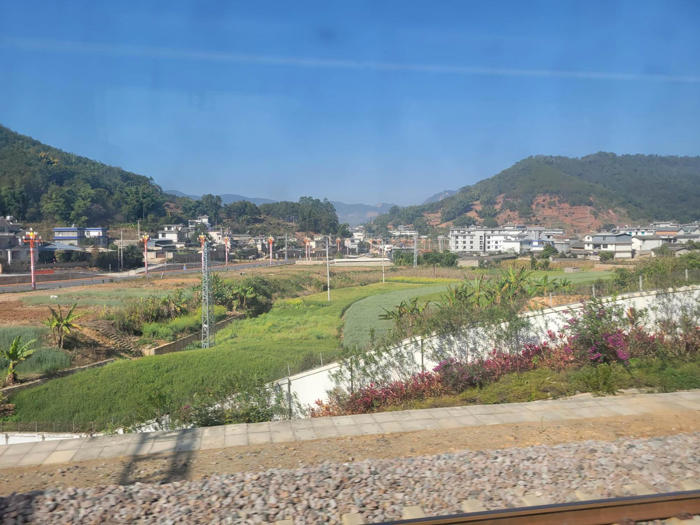
The view out of the window of the Laos-China Railway train to Xishuanghanna in the south of Yunnan province. Photo: Kristian Odebjer
Opened in December 2021, the LCR goes all the way to Vientiane, the capital of Laos, and is a bona fide Belt and Road project. Similar to the previous day, the train is packed.
As a foreigner, I am unable to book tickets directly through the official China Railway ticketing system, but I can still get advance tickets through online travel agents.
The system is paperless, so once tickets are confirmed, only passports are needed to enter the station and board the train.
Xishuangbanna is a tropical region in the far south of Yunnan (and China), known for its elephants and being home to a number of minority groups, including the Dai and the Hani.
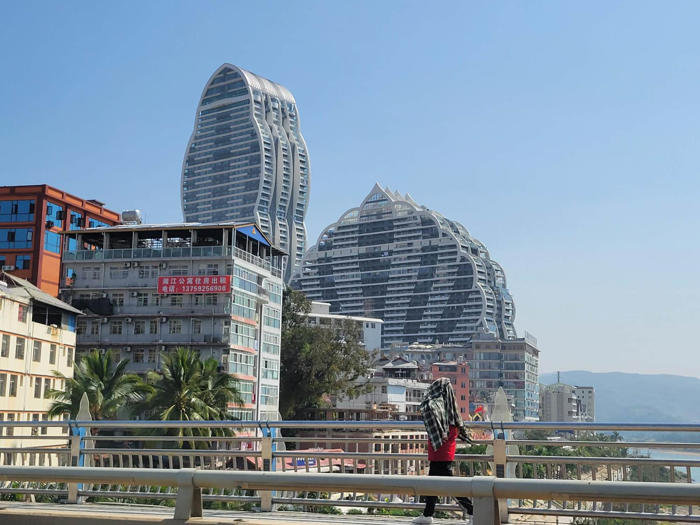
Buildings in the city of Jinghong, in Xishuangbanna, a tropical region in the south of China's Yunnan province. Photo: Kristian Odebjer
The region has close cultural and linguistic ties to parts of neighbouring Laos, Myanmar and Thailand, and after a cold and misty morning in Kunming, I am greeted by warmer and more humid weather as I step off the train at noon in Xishuangbanna's main city, Jinghong.
This is starting to feel like Southeast Asia.
Most of my fellow travellers are Chinese tourists who have come to this formerly remote corner of the country to enjoy their holiday in a comfortable climate, while the rest of China remains mostly cold and gloomy.
Some women and children have donned colourful outfits that seem inspired by the costumes China's ethnic minorities are usually pictured wearing.
Jinghong is located on the Lancang River, or as it is called outside China, the Mekong. I enjoy a late afternoon stroll along the riverbank as the sun slowly sets. There is a night market offering all kinds of snacks, many of them featuring tropical fruit.
While out on the town, I also drink pu'er tea, Xishuangbanna being home to some of the best varieties. I have always found this fermented tea hard to appreciate, but trying it "on location", while high on the spirit of adventure, it tastes divine.

A night market in Jinghong, Xishuangbanna. Photo: Kristian Odebjer
Day 3: Xishuangbanna - Boten
Before leaving Hong Kong, I had booked a ticket for the 11.22am international rail service from Xishuangbanna to Luang Prabang, the former royal capital of Laos. As I leave my hotel, however, I realise I have neglected to take traffic conditions into account.
It takes ages to get a ride via DiDi, and then longer to get out of the city centre. I can see the shiny green train already at the platform as my car arrives at the station, and then it leaves for Laos without me.
At the ticket office, I am told there are no more seats left on trains for Laos either on the same day or the next. I can feel my plan collapsing.
My wife is expecting me in Chiang Mai in two days, but this suddenly feels a distant prospect. Then I realise there must be a road heading south. Perhaps there is even another piece of Belt and Road infrastructure for me to investigate?
What follows is an almost transcendental experience in the realm of modern technology. I pull out my phone and key "Mohan" - the name of a Chinese town on the border with Laos - into DiDi.
Five minutes later I am in a car travelling along the G8511 expressway. My travel plan has unexpectedly changed, but thanks to the app I have barely lost any momentum.
The G8511 is the Chinese leg of a planned 1,900km Kunming-Bangkok Expressway. The Chinese section was completed in 2017 and makes for a very smooth ride with my driver, Mr Yang.
Like the railway segments on previous days, the expressway is a feat of engineering, with countless tunnels and bridges. And there is not much traffic: for long stretches we are travelling on our own through pleasant hill country.
One suspects it would take many multiples of the current volume of vehicles for the investment ever to yield a return.
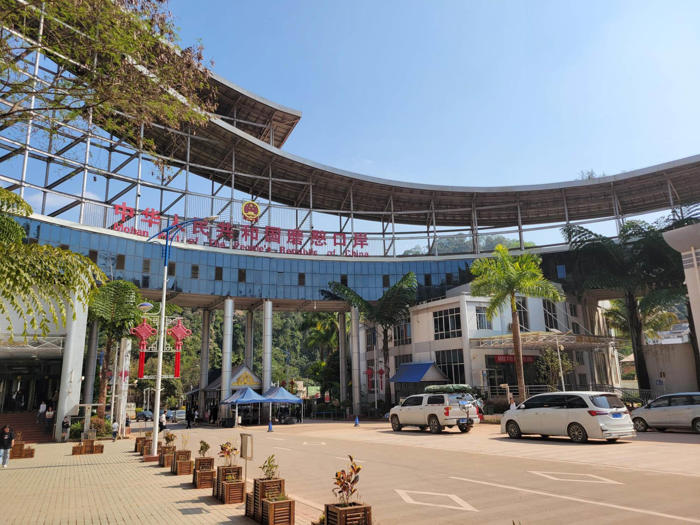
Cars entering China from Laos at Mohan Port. Photo: Kristian Odebjer
The border station is a simple brick building set in lush tropical vegetation. Inside is a single lane open for travellers on foot. Above the counter, a sign reads "Belt and Road VIP Lane". A trickle of cars and trucks pass through a barrier outside.
Among us dozen or so "VIPs" waiting to cross, I am the only one not carrying a plastic bag containing taro or aubergine to be traded on the other side.
With my passport stamped at the Lao border post, I step out into the Boten Special Economic Zone, a massive development full of empty high-rises that is apparently waiting for the Belt and Road Initiative to deliver on its promises.
The town was previously centred on a casino and an assortment of other shady businesses. It has now supposedly gone legit, but what that means in terms of actual business is not immediately clear. It feels more like a film set than a place for real people.
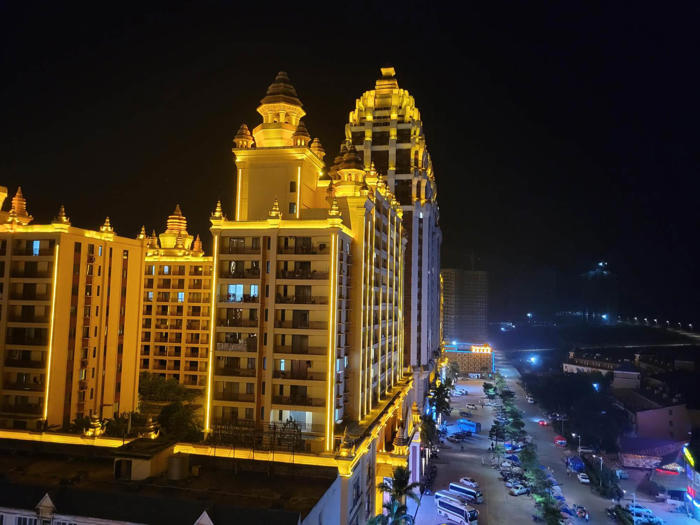
Illuminated buildings in Boten, in Laos' Luang Namtha province. Photo: Kristian Odebjer
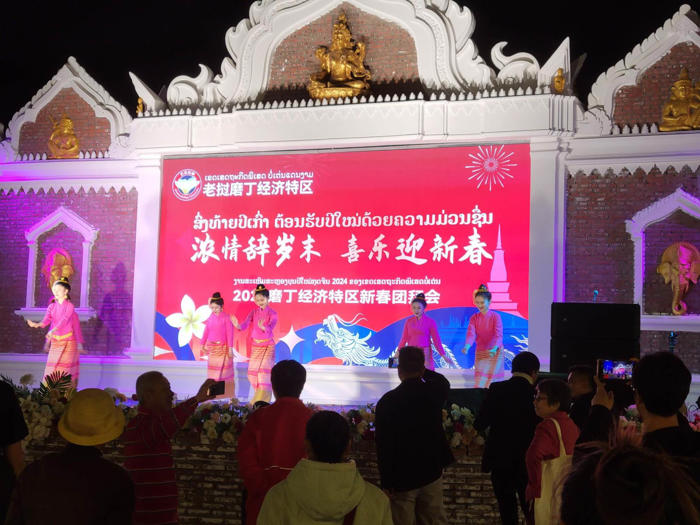
A dance performance at an outdoor market in Boten. Photo: Kristian Odebjer
I had been looking forward to a glamorous day in the Unesco World Heritage site of Luang Prabang, 290km to the south, but due to the train mishap I am still on the Laos-China border.
But then again, I now have a chance to ride on the Laos leg of the Kunming-Bangkok Expressway, and Boten, surreal a place as it is, has probably given me more of an insight into the Belt and Road Initiative than Luang Prabang would have.
Day 4: Boten - Chiang Khong
After a morning jog through idle eight-lane avenues in Boten, and breakfast in the mostly empty restaurant of a hotel seemingly designed for an Apec summit, it is time to hit the road again.
I now need to make my way across the rugged terrain of northwest Laos, much of which is a nature reserve. The newly built railway does not serve this part of the country and there are no buses.
Laos does not have DiDi or Uber, so I connect with a Lao driver online. Hieng promises to take me across northern Laos to the Thai border. At 10am he is ready outside the hotel with a large van.
As it turns out, this is just the vehicle needed to travel in comfort over some very bumpy roads. The grandly named AH3 (Asian Highway 3) is a country road that climbs and descends as required by the landscape - which is to say, a lot.

The author with driver Hieng at a service station along AH3 (Asian Highway 3), in northern Laos. Photo: Kristian Odebjer
This is quite a contrast to China's G8511, which shoots like a bullet through the mountains and across the valleys of Yunnan. Hieng and I do not pass through a single tunnel (or a single traffic light for that matter) during our five-hour trip.
What I see in Laos is gorgeous hill country, sparsely populated and very much lacking in visible development, except for a huge open-pit mine at the day's midway point.
Technically, this is still the Kunming-Bangkok Expressway, but in reality there is nothing "express" about it. Some sections lack paving and potholes are everywhere. Nonetheless, there is a large flow of trucks using Laos as a route between southwest China and northern Thailand.
In addition, I notice a small number of Chinese families driving their own cars, mostly fancy four-wheel drives.
Day four is mostly a lesson in what a lack of Belt and Road Initiative (and other) investment looks like. Perhaps we should not expect the AH3 to be modernised any time soon as Laos is reportedly burdened with a national debt corresponding to more than 100 per cent of gross domestic product, half of which is owed to China.
I leave Laos at Houayxay after only 24 hours in the country, and cross the Mekong on the Fourth Thai-Lao Friendship Bridge, completed as a joint Sino-Lao-Thai project in 2013 - the same year that the Belt and Road Initiative was announced.
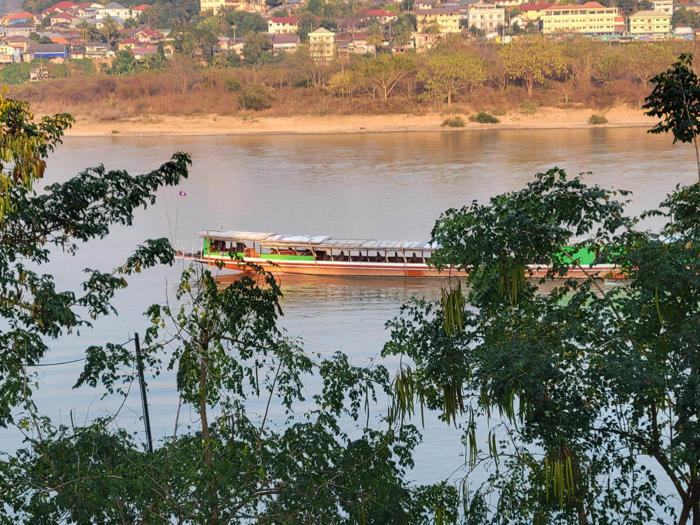
A boat on the Mekong in Chiang Khong, in Thailand's Chiang Rai province. Photo: Kristian Odebjer
So you could say that the day began (Boten) and ended (Friendship Bridge) with the initiative, with very little of it visible in between.
It feels good to be back by the Mekong, now 300km downriver from my last encounter with the "Big Muddy", in Xishuangbanna.
Chiang Khong, in Thailand's Chiang Rai province, is by any standard a backwater, but compared to the quiet of northwest Laos it feels more like Mong Kok.
I have logged another 200km on this day, for a total of 2,400km.
Day 5: Chiang Khong - Chiang Mai
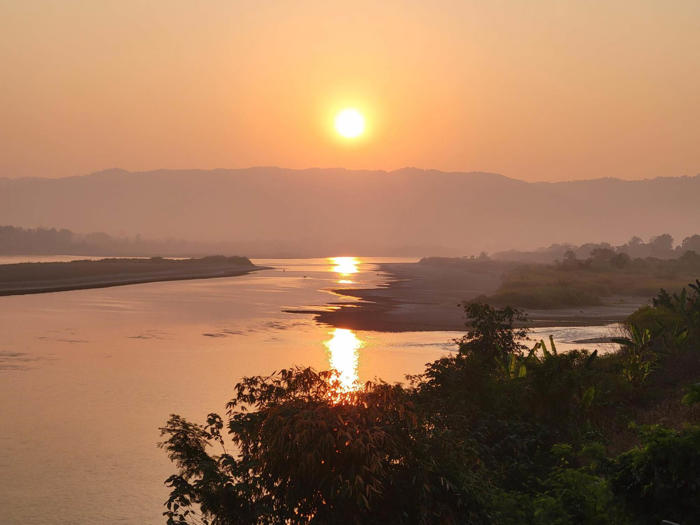
Sunrise over the Mekong River in Chiang Khong, northern Thailand. Photo: Kristian Odebjer
My journey has now taken me deep into the Golden Triangle. The "tripoint", where the borders of Laos, Thailand and Myanmar intersect, is just 65km upriver from Chiang Khong.
While the Golden Triangle might conjure up images of drug lords with private armies, none are on display on my morning run. Instead, the scene is one of near total tranquillity, the sun rising over the green hills on the Lao side of the Mekong.
I spend the rest of the morning watching the river flow from a wooden chair on my hotel balcony. The Mekong is the original superhighway of Southeast Asia, and I have a sensation of being in the presence of something timeless.
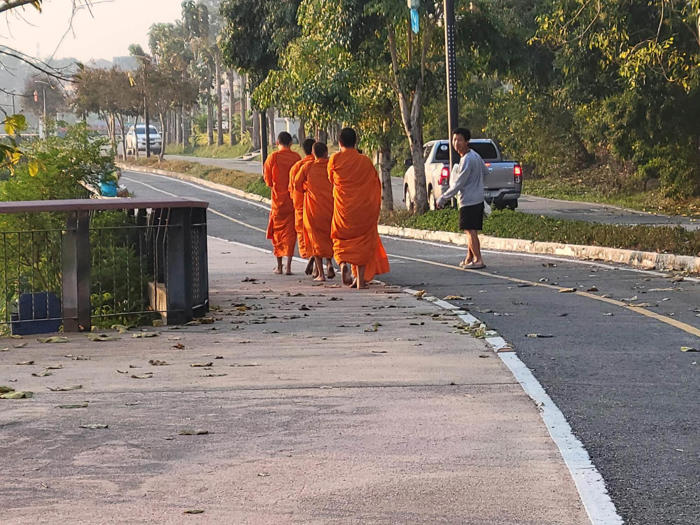
Buddhist monks out to collect morning alms in Chiang Khong. Photo: Kristian Odebjer
From my understanding, Thailand is considered a relatively strong supporter of the Belt and Road Initiative. That notwithstanding, the initiative's flagship project in Thailand - a high-speed rail line connecting the Laos-China Railway all the way down to Bangkok - has made limited progress so far.
I take the bus for the final stretch of my expedition into Chiang Mai. The road is mostly flat, traversing the fertile river plains of Chiang Rai and Chiang Mai provinces.
There are a bunch of Chinese tourists with me on the bus, which would be a welcome sign for Thailand post-Covid-19. The country relies heavily on tourism - especially Chinese tourists - and the two nations have agreed to implement a mutual visa-free regime in the hope of boosting travel flows in both directions.
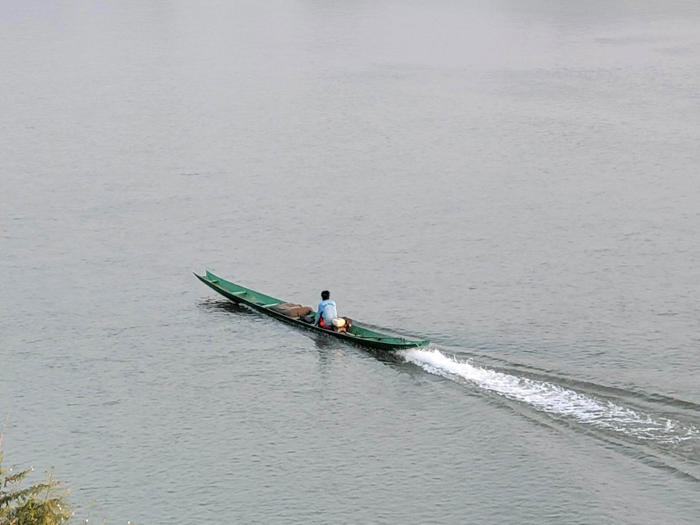
A fisherman on the Mekong in Chiang Khong. Photo: Kristian Odebjer
We pull into the Chiang Mai bus terminal a few minutes early, at 5.30pm.
The distance covered on Day 5 is 350km, for a grand total of 2,750km from Hong Kong to Chiang Mai.
I feel oddly down that my little adventure is over.
The road itself has been one heck of a destination, so much so that my actual destination, Chiang Mai - that jewel of northern Thailand, with its temples and street markets - initially feels stale and predictable in comparison.
Bruce Chatwin wrote about how a traveller sometimes outruns his own spirit. Is that happening to me? Luckily Mimi is there to greet me and after a steaming, spicy bowl of khao soi my spirit seems to catch up.
More Articles from SCMP
This article originally appeared on the South China Morning Post (www.scmp.com), the leading news media reporting on China and Asia.
Copyright (c) 2024. South China Morning Post Publishers Ltd. All rights reserved.
